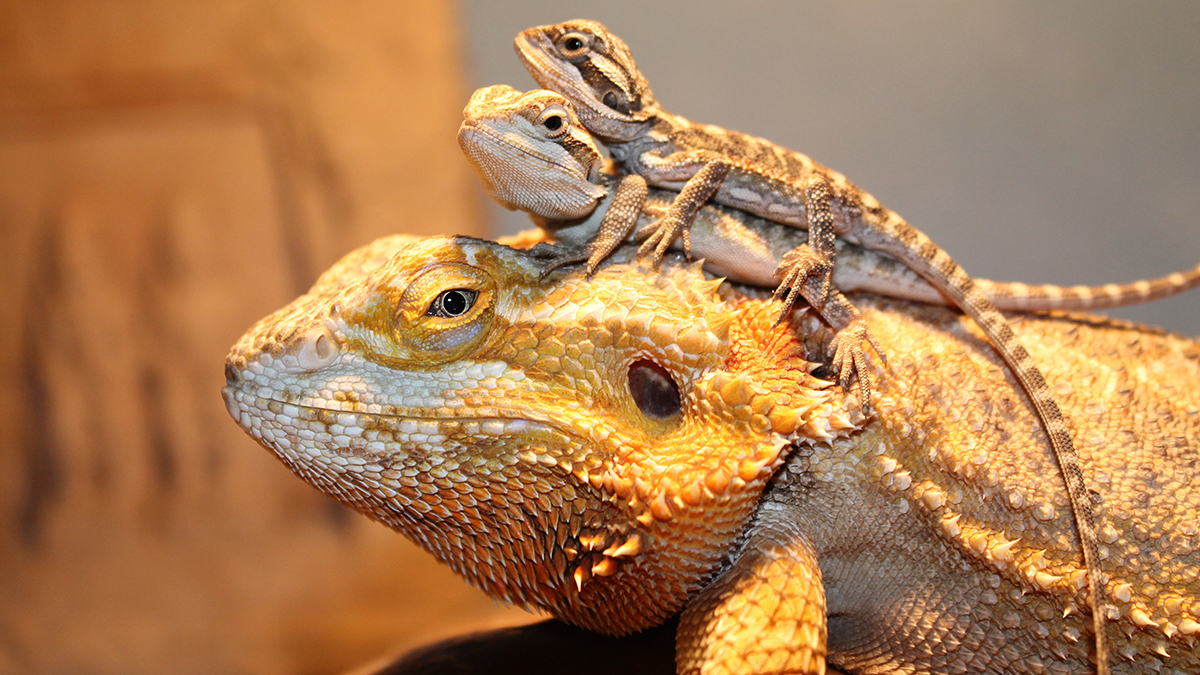
Species Overview
- Common Names: Bearded Dragon
- Scientific Name: Pogona vitticep
- Distribution: Australia
- Adult Size: 6-24”
- Life Expectancy: 5-15 years
Bearded Dragons are among the most popular pet reptiles in the hobby. Their unusual behaviors and docile nature make them excellent pets for first-time reptile hobbyists. All Bearded Dragons found in the USA are captive-bred. Many different color morphs are becoming available, making the Bearded Dragon an excellent choice for any level reptile keeper.
About the Bearded Dragon
Bearded Dragon Pet Care: Habitat Set-Up
Habitat
- Juvenile Bearded Dragons need a minimum of a 20-gallon terrarium. Juveniles can be housed together in a 30-gallon terrarium.
- Adult Bearded Dragons need a minimum of 40+ gallons of terrarium.
- Provide plenty of hiding and basking places.
- Thick branches, rocks, or Mopani Wood is an excellent choice for climbing and basking.
Heating
- Daytime Terrarium Temperature: 83-88° F.
- Basking Spot: 95-105° F.
- Nighttime temperature is natural and can be achieved by turning off all overhead heating devices and leaving a ReptiTherm® under tank heater (UTH) on 24 hours a day.
- Zoo Med’s Basking Spot Lamp, PowerSun®, Repti Halogen, Ceramic Heat Emitters, and ReptiTherm® UTH are excellent choices for heating Bearded Dragon enclosures.
Lighting
- UVB lighting and heat are essential for Bearded Dragon pet care to process calcium in captivity.
- Without UVB lighting, Bearded Dragons will develop serious health problems like Metabolic Bone Disease (MBD).
- UVB Lighting should be left on for 10-12 hours daily and turned off at night.
- Zoo Med’s ReptSun® linear and compact fluorescent lamps are excellent choices for providing bearded dragons with UVB. The PowerSun® is a unique way to offer UVB and basking heat in one light!
Substrates
- Bearded Dragons live in a dry, sandy place in the wild and will do well on a variety of sand-type substrates in captivity.
- Hatching Bearded Dragons will do best on Cage Carpet, such as Zoo Med’s Eco Carpet.
- Excavator™ Clay Burrowing Substrate will allow you to create a naturalistic terrarium complete with burrows and tunnels for your animals.
- ReptiSand® land ReptiFresh® are also excellent choices for housing Bearded Dragons.
Temperament
- Bearded Dragons are active during the day and sleep at night. They are generally friendly and easy to handle, so owners rarely see their aggressive displays. When the dragon feels threatened, its throat expands, and the spines around its neck stand up. Another key point is that male bearded dragons should be housed separately, as they can be territorial.
Diet and Nutrition
- Bearded Dragons are omnivorous reptiles that change their diet throughout their lives.
- Juveniles will need to be fed pinhead to small-size crickets daily, along with other small insects, such as mealworms. Zoo Med offers a variety of Can O’ Insects and canned diets, making providing a varied diet convenient.
- Collard or Dandelion Greens, Romain lettuce, and other veggies can be offered 1-2 times per week.
- Always remove uneaten food after each feeding.
Pet Safety
- Use caution when handling pets, and remember they may bite or scratch (especially when stressed).
- Supervise children around pets.
- ALL ANIMALS can potentially carry viral, bacterial, fungal, and parasitic diseases contagious to humans.
- Thoroughly wash your hands with warm, soapy water before and after contact with any pet or its habitat.
- Adults should assist children with handwashing after contact with a pet, its habitat, or aquarium water.
Related Searches
Reptile Care